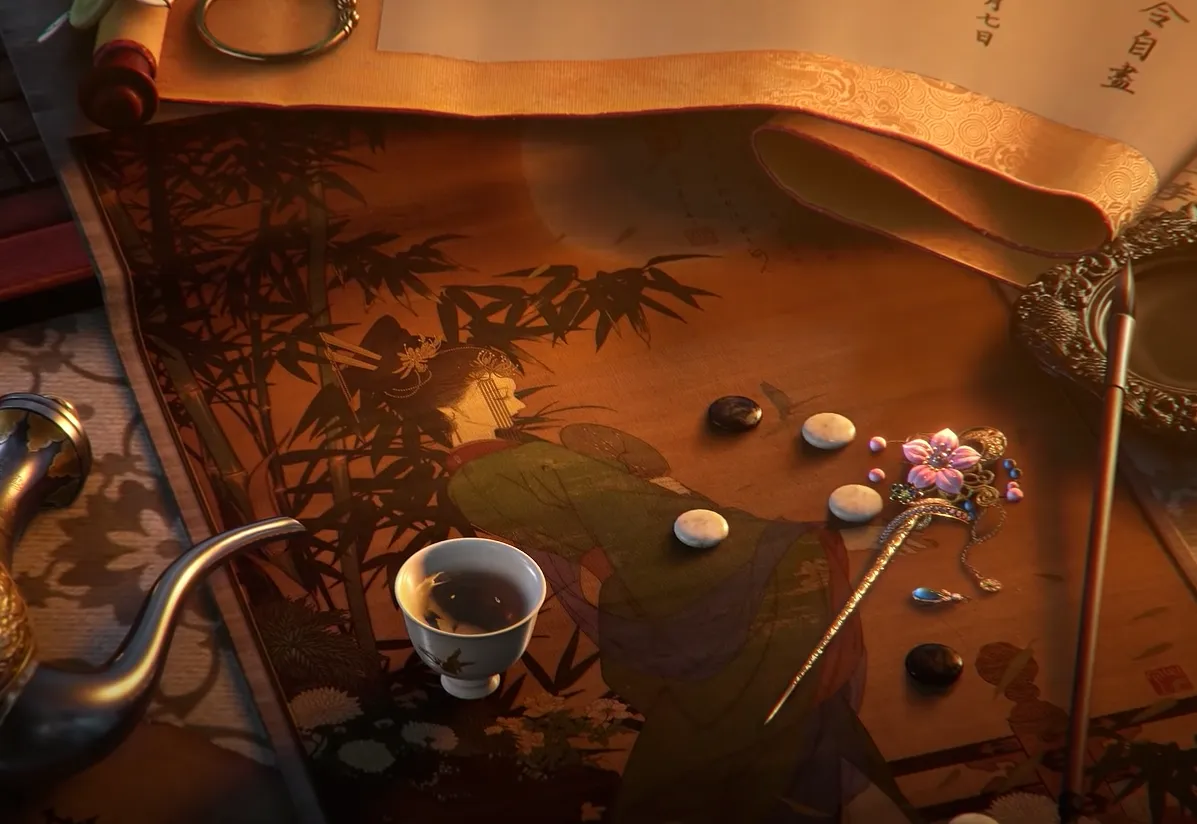Melodies of Peace in Where Winds Meet sit in an odd place in the game’s design. They’re never as flashy as a new spear form or as obvious as a boss talent node, yet they quietly decide how tanky you are, how many Mystic Arts you can slot, and how rewarding exploration feels. The currency that feeds them is even more understated: Oddities, which the game later renames and groups as regional Life Materials.
Melodies of Peace and Oddities: the core loop
Early in Qinghe, you meet Qi Sheng, a trapped NPC near the Tai Chi bear encounter. Freeing him unlocks Melodies of Peace, a dedicated progression tree that:
| Category | What Melodies of Peace can grant |
|---|---|
| Survivability | Max HP increases, extra endurance, and direct health bar upgrades. |
| Combat power | Additional Mystic Art slots, passive bonuses, and occasionally gear pieces or quest items. |
| Exploration support | Upgrades that ease traversal or make other systems (like Oddity collection itself) feel less punishing. |
Qi Sheng acts as the Oddity exchanger for Melodies of Peace. You bring him specific Life Materials from each region, and he turns them into progression along linear paths with occasional branch points. You don’t freely cherry-pick any node; new melodies unlock in sequence, with a few sub‑choices sprinkled in.
That structure makes Oddities more than just checklist fodder. They are effectively a second experience bar that runs parallel to your character level, with direct control over health and utility in ways that regular leveling and gear tuning cannot fully replicate.
Oddities, Life Materials, and map icons
The game uses the term “Oddities” for the collectible behavior and “Life Materials” when those items sit in your inventory or are spent at an Oddity Exchange. On the world map and minimap, they share a consistent visual language:
| Element | How it appears | What it means |
|---|---|---|
| Oddities in general | Butterfly or fairy-like icon; on the mini-map they show as small black oddity symbols when in range. | A nearby object or creature that can be turned into a Life Material through a small interaction or puzzle. |
| Oddity Exchange / Oddity Collector | Butterfly icon ringed by a white circle. | Qi Sheng’s role in Qinghe and equivalent NPCs in other regions who trade Oddities for Melodies of Peace upgrades. |
| Regional Oddities | Same butterfly base icon, tinted differently by type. | Different Oddity families (Mantises, Hives, Flowers, etc.) with unique collection mechanics. |
Oddities are not pinned to the large world map by default. Instead, the mini‑map in the top left of the screen is the reliable signal. Once an Oddity is within that mini‑map’s radius, its icon appears and you can sweep the area to identify the trigger — a crate, a toad, a mantis, a nest.
Qinghe Oddities: five Life Materials and how they work
Qinghe is the first region, and it introduces five distinct Oddity types. They share a theme: none are passive pickups. You must either solve a micro‑puzzle or react quickly to a fleeing creature.
| Qinghe Life Material | Where it appears | Collection mechanic |
|---|---|---|
| Ironwing Mantis | On logs, rocks, or the ground, surrounded by purple sparkles. | Interact to “observe” the mantis, chase it as it flies off, and interact again when it lands to capture it. |
| Enchanting Lotus | Purple flowers shrouded in poisonous miasma, often in clusters. | Use Wind Sense to trace purple smoke lines to butterfly swarms, shoot each swarm with arrows (fire helps), then collect the flower once the miasma clears. |
| Redmist Beetle | Above glowing red mushrooms emitting a reddish aura. | Locate the bug cloud hovering over the mushrooms and physically intersect it by jumping up or leaping from nearby terrain. |
| Dagger General | Beneath piles of breakable jars, crates, stones, and other debris that audibly chirp. | Smash the pile with your weapon, then quickly interact in the cleared spot to catch the cricket before it escapes. Multiple can hide under one pile. |
| Whisper Hive | Hanging from trees and cliff faces, never on the ground. | Stay at range, shoot the hive with fire arrows to pacify the wasps, then climb up and loot the empty hive. |
Every Qinghe Life Material contributes to the same regional Melodies of Peace branch when you hand them in at Qi Sheng’s Oddity Exchange. That branch is what eventually upgrades early health and Mystic Art capacity, so it’s worth actively detouring for these icons as you explore Verdant Wilds, Moonveil Mountain, Sundara Lands, and the General’s Shrine surroundings.
Kaifeng Oddities: new Life Materials, same progression stake
By the time the story pulls you across the river into Kaifeng, Melodies of Peace are already woven into your build, and the game quietly doubles down. Kaifeng offers five new Life Materials with their own micro‑games:
| Kaifeng Life Material | Behavior on the field | How to capture |
|---|---|---|
| Heartsoothe Twig | Appears as a moving butterfly icon; actually carried by a golden bird flying a fixed pattern overhead. | Reach the spot, look up, learn the bird’s route (straight line or square), shoot it with an arrow so it drops the twig, then pick up the gold‑sparkling item on the ground. |
| Moonbeam Toad | Small golden frogs that sprint away, leaving gold sparkles in their wake. | Chase and interact with the toad directly; the challenge is speed and pathing rather than a puzzle. |
| Midnight Nibbler | Rats hiding under noisy crates or rock piles, echoing Dagger Generals but with different models and sound. | Use Wind Sense to highlight the pile, break it, then sprint after the glittering rats and interact to grab them, often several from one stack. |
| Thunder Fluff | Tufts in grassy fields that throw puffs into the air when disturbed. | Interact with the plant, then chase and tag the airborne fluffs before they land. |
| Swallow’s Rest | Nests perched on roofs and similar high spots, sometimes with a bird still present. | Approach so the swallow takes off, then loot the abandoned nest and claim it as a Life Material. |
Kaifeng’s Oddity Exchange mirrors Qinghe’s: Kaifeng Life Materials feed a separate Melodies of Peace branch that uses only that region’s Oddities. You can’t, for example, spend Whisper Hives to progress a Kaifeng‑specific node. Each region enforces its own economy.
Oddity Collectors and regional Melodies of Peace trees
Oddity Collectors are static NPCs that anchor Melodies of Peace in each region. Qi Sheng is the most visible example in Qinghe, but each area has its own specialist standing in for him. Their roles are consistent:
| Role | What the Oddity Collector does |
|---|---|
| Exchange hub | Trades region‑specific Life Materials for progression along the Melodies of Peace tree. |
| Gatekeeper | Controls access to HP boosts, endurance upgrades, extra Mystic Art slots, and sometimes quest‑critical gear. |
| Tutorial anchor | Introduces the first Oddity puzzle, like the beehive you shoot with fire arrows to align with the Tai Chi bear fight. |
Melodies of Peace nodes are linear but not flat. Unlocking one melody reveals the next in line, with branch points that let you choose between, say, a raw HP increase and a passive or utility node. The tree is clearly labeled and uses Life Materials as its only currency; it does not draw from coins, Echo Jade, or Enlightenment Points.
That separation matters. Even if your world level, Inner Ways, and gear tuning lag, a well‑fed Melodies of Peace tree can prop up your build by making you harder to kill and giving you room for more Mystic Arts, which in turn reshapes how you approach bosses, stealth, and exploration puzzles.
Combat upgrades tied to Oddities
Melodies of Peace touch several systems that otherwise sit in their own silos. A few categories stand out in early and mid‑game progression:
- Health and endurance: Upgrades here directly push your survivability, stacking with potion improvements from Medical Tales and armor tuning.
- Mystic Art slots: Extra slots let you layer support skills like Veil of Stillness, Touch of Death, Heavenly Snatch, or Blinding Mist on top of your core movement and damage tools.
- Quest‑linked items: Some melodies unlock unique gear or items that appear later as hooks in side stories or exploration quests.
In practice, treating Oddities as optional flavor quickly catches up with you. Bosses and exploration chains such as “Echoes of Old Battles”, “Blind to the World,” or “Afterglow” lean on Mystic Skills, Inner Ways, and lightness techniques, and having extra slots or slightly larger HP buffers changes how punishing those sequences feel.
Finding Oddities in moment‑to‑moment play
Oddities rarely sit directly along the golden main‑quest path, but they cluster near other sentient beings, shrines, and exploration content. Several tools and habits make collecting them less random:
| Tool or habit | How it helps |
|---|---|
| Mini‑map watching | The black Oddity icon appears whenever you pass near one. A quick sweep of the surroundings usually reveals the trigger pile, flower, or creature. |
| Wind Sense | Highlights interactive piles, smoke trails to butterfly swarms, and other subtle cues around Lotus, crickets, and rodents. |
| Fire arrows on hand | Many Oddities (Whisper Hives, Enchanting Lotus, some shrine puzzles) expect you to burn vines or ignite hives without needing to backtrack. |
| Lightness skills and Mighty Drop | Reaching beetles over mushrooms, nests on rooftops, or mantises on ledges is safer when you can chain jumps and cancel fall damage. |
Oddities also sit adjacent to other systems. The very first beehive Oddity is embedded in the Tai Chi bear tutorial, and various Life Materials hide around boundary stones, underwater shrines, and puzzle corridors tied to side stories. Treating every butterfly icon as an invitation to poke at the environment rather than a distraction leads to a more natural accumulation of Life Materials.

Choosing early Melodies and weapons after your first Oddity
Once Qi Sheng sends you to retrieve that first beehive and you return with an Oddity in hand, he opens the Melodies of Peace screen and, crucially, offers initial martial options in exchange for Oddities. That’s where build direction and survivability start to diverge:
- Panacea Fan: Recommended early choice because it directly improves healing at a stage where potions are weak and medicine is expensive. It reduces pressure in both solo exploration and side‑quest boss fights.
- Thundercry Blade and Vernal Umbrella: Strong alternatives tied more to damage and style, but they unlock later in Kaifeng if you skip them here. Taking them early front‑loads combat variety at the cost of healing comfort.
Those initial decisions sit on top of your basic talent tree (Basic, Arena, Boss) and weapon selection. Basic Talents control foundational mechanics, Arena talents matter for PvP, and Boss talents target repeatable farming fights. Melodies of Peace layer on top with HP and Mystic Art slot changes, making Oddities a quiet but central axis in how your character feels to play.
Treat Oddities as part of the same mental category as Boundary Stones and Wayfarers: regional infrastructure you should engage with as soon as you see their icons. They are short, self‑contained interactions that feed directly into Melodies of Peace, and through that tree, they define how many tools you can slot, how much punishment you can take, and how smooth Qinghe and Kaifeng feel as you push deeper into Jianghu.


